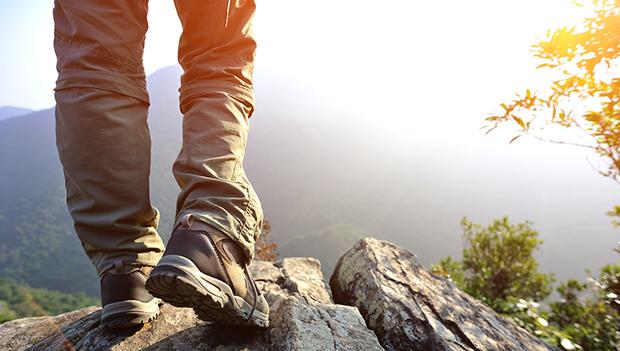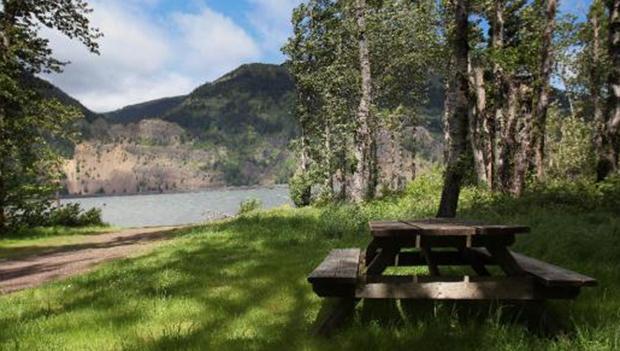A Guide to Camping Shoes

The right camping shoes allow you to explore any terrain in safety and comfort. While some athletic or outdoor shoes suffice for certain camping situations, in this article we will concentrate on hiking shoes. Hiking shoes are the preferred go-to option for virtually any type of camping.
Below we will review:
- Ankle Support
- Shoe Stiffness
- Upper Materials
- Traction
- Choosing the Right Shoe
Recommended: Great Hikes to Get in This Spring
Ankle Support: Do You Need It?
For most people, low-cut hiking shoes that don’t provide ankle support work just fine for their camping and hiking needs. These shoes are designed for day hiking on most terrain.
For people who want ankle support, there are hiking boots. Generally speaking, they come in three varieties: no ankle support, mid-cut, or high-cut boots. Whether you want ankle support is largely a personal preference. While boots with ankle support were originally designed for multi-day backpackers, day hikers certainly can wear hiking boots if they prefer them, and many backpackers go for hiking shoes or even trail runners rather than boots.
Doing long or multi-day hikes at State Forest State Park in Colorado? You might want a boot with some ankle support to help you through the park’s many trails that take you through the Rockies and are rated as hard, such as the Kelly Lake Trail which is over 14 miles and winds through stunning alpine terrain. The park has 249 campsites, including everything from cabins to primitive sites for backpackers.

Shoe Rigidity: Flexible vs. Stiffness
When it comes to shoes, flexibility and stiffness are yin and yang. If you get more of one, you will correspondingly get less of the other. Flexibility in a shoe allows you to feel the ground beneath you. As you step on a rock, for example, your foot will wrap around it. In contrast, stiffness means you feel the ground less, which can contribute to the feeling that you’re floating over the trail.
The three shoe components that determine flexibility and stiffness are midsoles, shanks, and plates. Midsoles are the key providers of cushioning and shock absorption in a shoe. Shanks add to the load-bearing abilities of a shoe, and may cover the entire shoe or just a portion of it. Plates are located between the midsole and the outsole and protect the feet from rocks and stones.
A more flexible shoe will work on easy terrain, like soft, packed earth. A stiff shoe is better for harsher or more technical terrain, like rocky trails. The distance you’ll be hiking is also a factor, with flexible shoes being preferred on shorter hikes and stiff shoes or boots generally being a better fit for longer hikes. But as with most shoe components, flexibility versus stiffness really is about what feels good to you.
Going for an easy hike in the soft, red earth at Red Top Mountain State Park in Georgia? Grab your comfortable and flexible shoes for the terrain here featuring popular trails like the 3.4 mile Iron Hill Trail. There’s plenty of camping too, with 126 campsites, including modern cottages, yurts, and pioneer camping.

Recommended: Where to Enjoy the Spring Thaw in the Midwest
Upper Materials: Waterproof, Leather, and Synthetic Options
The upper materials of a shoe impact its durability, weight, breathability, and water resistance.
The upper material may be some type of leather or synthetic material, like polyester. As a rule of thumb, leather shoes tend to be more durable and offer better abrasion resistance, while synthetic shoes tend to be lighter and easier to break-in.
When it comes to waterproofing, which can be necessary in either leather or synthetic shoes, keep in mind that water resistance is diametrically opposed to breathability. Leather shoes will have a natural water resistance (but may not be totally waterproof). Shoes that are billed as water-resistant will have a waterproof membrane (such as Gore-Tex®).
Waterproof shoes are great if you’ll be trekking in a wet environment, but not as great if you are hitting the trails in a warm, dry area, since your shoes will not be breathable, contributing to sweaty, hot feet.
A final consideration about the upper materials is if you want insulation. Typically, this is reserved for hiking in cold environments and many boots designed for mountaineering feature insulation for trekking in snow or across glaciers.
If you are hiking in Oregon, you almost certainly want weatherproof shoes. Viento State Park, a secret gem close to Mount Hood, has easy and hard trails within the park along Viento Creek, as well as 68 campsites.

Traction: What Kind of Terrain Will You Encounter?
The bottom of a shoe, or the outsoles, is almost always made of rubber. Sometimes carbon is added to boost hardness in hiking boots, but it’s not the materials that vary so much as it is the traction pattern, known as the lug pattern. Lugs are the traction in the form of bumps, grooves, circles, wiggles, and other shapes and come in a variety of depths.
The best all-purpose traction for easy and moderate trails will have a mixture of multi-directional lugs and circles. Deeper traction is needed for moderate to hard hikes for improved traction on loose surfaces, like gravel and mud.
Looking to hike in Pennsylvania? Check out World’s End State Park, which is beloved for its high number of high-quality hiking trails that feature waterfalls, creeks, gorges, vistas, whitewater, huge boulders, and rock mazes. Grab your all-purpose traction hiking shoes and stay at one of the 95 campsites.

Recommended: Preparing for Spring Camping
Choosing the Right Shoe Size and Fit
When trying on shoes, it might be a good idea to have a sales person help you with sizing. Every boot fits differently, even if you’ve had the same hiking shoes in the past. Be sure to bring orthotics with you when trying on shoes, and wear socks you would wear when hiking, like Cloudline socks or GobiHeat socks. (Hot tip: Apex Members get discounts on these socks and other outdoor adventure items.)
Another good tip is to try on shoes towards the end of the day, when your feet may be a little more swollen. All of these factors will help you avoid getting the wrong size, which is usually too small, rather than too large. Remember, when you’re hiking you will be wearing thicker socks and need more room in your shoe for trekking than you would in your usual street shoes. When you get the shoes home, wear them around the house before hitting the trail to help break them in.
Are you ready for your adventure? Plan your camping trip!
Check with your Local Government Organization
Many policies have been established to counter and control the coronavirus outbreak. State and local officials have been taking decisive action to stop the spread. The policies vary by state, sometimes to a great degree. When you book a reservation, make sure to review the park and state's latest rules and regulations prior to your visit.
For COVID-19 updates, please visit our Impacted Park List and Reservation Guide for the latest information.